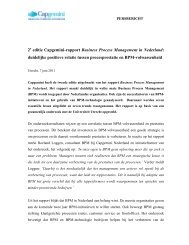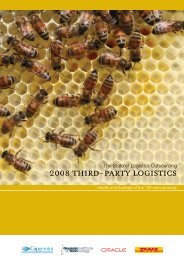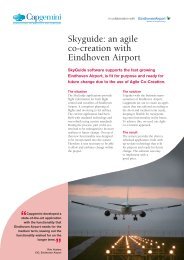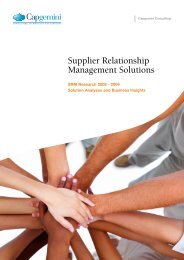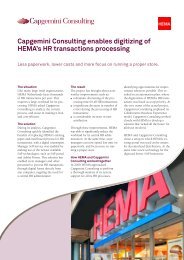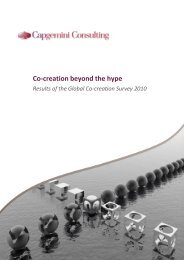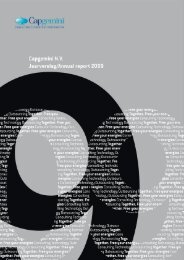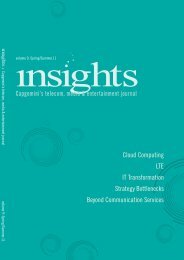Global CIO Survey 2008 - Innovator vs Operator - Capgemini
Global CIO Survey 2008 - Innovator vs Operator - Capgemini
Global CIO Survey 2008 - Innovator vs Operator - Capgemini
- No tags were found...
Create successful ePaper yourself
Turn your PDF publications into a flip-book with our unique Google optimized e-Paper software.
<strong>Capgemini</strong> Consultingthe way we see it<strong>Global</strong> <strong>CIO</strong> <strong>Survey</strong> <strong>2008</strong>The Role of the IT Function in Business Innovation<strong>Innovator</strong> <strong>vs</strong> <strong>Operator</strong>
ContentsForeword 1Participating Companies and Organisations 2Executive Summary 4Innovation—A Definition 5Information Technology and the Role of the IT Function 6Qualifying for a Role in Business Innovation 10Leadership—The Key to Successful Innovation 14Redefining the Role of the IT Function 16Our Point of View 20About the <strong>Survey</strong>—Intention and Method 24About <strong>Capgemini</strong> Consulting 25Copyright © <strong>2008</strong> <strong>Capgemini</strong>. All rights reserved.
<strong>Capgemini</strong> Consultingthe way we see itForewordIn today’s business world, innovationis inseparable from technology.Individuals are moving ahead oforganisations in their ability to exploitnew information and communicationtechnologies and are increasingly ableto create business value with minimalsupport. This fast-changing relationshipbetween business and technologycreates a major new opportunity fortoday’s <strong>CIO</strong> to build an IT functionthat delivers more value than everbefore. However, we believe that theopportunity will not just ‘arrive’ butwill require carefully thought throughactions to become reality.The purpose of this survey is toexplore the views of <strong>CIO</strong>s across theglobe on how this increased access tonew technologies and information ischanging their role, and the role oftheir IT function. Among the issuesaddressed are:■ Why is it that the IT function is sorarely seen as a driver of innovation?■ What is the appropriate balance offocus between innovation andoperational efficiency?■ How can a <strong>CIO</strong> create the space andculture to foster innovation?■ What is the “right” role and strategyfor the <strong>CIO</strong> and IT function in thefuture?As well as reporting and commentingon the findings of the survey, thisreport proposes strategies that<strong>CIO</strong>s may wish to adopt to workmore effectively with the rest ofthe organisation and enablebusiness innovation.The survey, the latest in a series ofinternational <strong>CIO</strong> surveys undertakenby <strong>Capgemini</strong> Consulting 1 , is basedon one-to-one interviews withnearly 400 <strong>CIO</strong>s across the world,representing all industry sectors.We thank all the <strong>CIO</strong>s whoparticipated in this year’s study forsharing their opinions with us, andhope that this publication stimulatesthoughtful discussion.Olivier Sevillia<strong>Capgemini</strong> ConsultingWest EuropeCEOPaul Nannetti<strong>Capgemini</strong> ConsultingContinental Europe and Asia PacificCEOEric Monnoyer<strong>Capgemini</strong> ConsultingVice PresidentBIS <strong>Global</strong> Leader1 Last year’s survey (IT Agility - Enabling Business Freedom) explored the views of <strong>CIO</strong>s of major organisations on agility and its impact on IT.1
Participating Companiesand Organisations<strong>Capgemini</strong> Consulting would like to thank all 395 participating <strong>CIO</strong>s and seniormanagers who gave time to be interviewed for this <strong>CIO</strong> survey. Besides theorganisations listed below, 30 additional companies participated in the survey butrequested to remain anonymous.Business ServicesAdeccoAgapes Restauration<strong>Capgemini</strong>CB Richard EllisDescours et CabaudDet Norske Veritas (DNV)Fast Search & TransferGroup 4 SecuricorMesse München GmbHOpen TextPon Equipment & Power SystemsProsegurSecuritasSSPConsumer Products & RetailAce HardwareAhold EuropeBonduelleCoca-Cola Erfrischungsgetränke AGCoopCoraDick’s Sporting GoodsEuromasterFindus Sverige ABFriesland FoodsGrolschGroupe Go SportICAIkea NederlandJD GroupJulius MaskeKelloggs IberiaMarine HarvestNestlé WatersNorautoOffice Depot EuropeOffice MaxPaulig Coffee DivisionPhilips ElectronicsPremier FarnellREXELRieber og SønRudolf Wöhrl AGSAB MillerSchuitemaSony Ericsson Mobile CommunicationsSTIME (Filiale informatique du Groupementdes Mousquetaires)Swedish Match NordicSystembolagetTomTomTradekaUlta CosmeticsVandemoorteleEnergy & UtilitiesAker KværnerAREVAArkemaASERCO / Grupo AgbarAVR - Van GansewinkelBJ ServicesBrabant WaterCentricaCEPSACGNPCClariantDONG Energy S&DE.ON UKElyoENAGASEnbridgeEndesaEnecoFortumGas NaturalGaz MétroGöteborgs EnergiKuwait Petroleum ItaliaLyonnaise des eauxManitoba HydroNational Oilwell Varco Distribution ServicesNeste OilNTE (Nord-Trøndelag Everk)PetrofacPetrom S.A.Red Eléctrica de España (REE)Repsol ypfRowan CompaniesRTERWE AGRWE DeaShell Gas & PowerSibelgaSuez Energy North America, Inc.TennetTernaUNION FENOSAVattenfallVeolia EnvironnementViesgo EnelVitensFinancial ServicesABN AMROABPAgrupació MutuaAllianzAllianz Elementar Versicherungs-AktiengesellschaftAllianz NederlandAtlantis SegurosBanco Caixa GeralBanco Sabadell AtlánticoBank of CyprusBNbankBNP ParibasCAIFORCardif EspañaCCRCECCredit Agricole BelgiumCrédit du NordCZBadeniaDSWFolksamFondiaria SaiGE Money BankGenworth FinancialGroupamaHandelsbankenHBOS Corporate BankingIndustriens PensionInternational Card ServicesJyske BankKBC GroupKuntien eläkevakuutusLänsförsäkringarLeasint S.p.A.LuottokuntaMAIFMAPFREMenzis zorg en inkomenMillennium BankMutua PelayoPaylife Bank GmbHPGGMProCredit BankRaiffeisenbank Austria ZagrebSanitasSiemens Financial ServicesSparebank1 Midt-NorgeSplitska banka Societe Generale GroupSwedbankTD Meloche MonnexTexas Medical Liability TrustUBPUniCredit Tiriac BankUnivéUniverso ServiziUnivé-VGZ-IZA-TriasVärdepapperscentralenVVAA2
<strong>Capgemini</strong> Consultingthe way we see itManufacturingAB VolvoABB North Europe RegionAlfa LavalArc InternationalArcelor StainlessAstellas PharmaBayer Business ServicesBlack & Decker Hardware and HomeImprovementBluestar SiliconeBMW China Automotive Trading Ltd.BMW EspañaBosch Rexroth ChinaBritish VitaCanon EuropeCooper Standard AutomotiveCosunEADS DSForbo GroupFreescale<strong>Global</strong> DinamicsGrupo UralitaGruppo RadiciHendrix GeneticsHolmenHospiraHuaxin Cement Company Ltd.KemiraKomatsu Europe InternationalKvernelandLafargeLanxess CorpLennox EuropeMerck Farma y Química, S.A.Metals USAMTS GroupNCC RoadsNorske SkogNXP SemiconductorsOcéOrganonPG GroupPlastic OmniumRenault TrucksRhodiaRockwell AutomationRONAL GmbHSaab ABSanofi Pasteur MSDSCA ABScaniaSchneiderSEATSKFSolvay PharmaceuticalsStora Enso ABTrelleborg ABUPM-KymmeneVolvo BussarVolvo CarsVolvo TrucksYamaha Motor Corporation, USAZF Group NAOPublic, Government & SocialANPEAntoniusMesosGroepBergen Kommune (City of Bergen)Bundesministerium des Innern (BMI)CapioCentre des Technologies de l’Information - Etatde GenèveCNAM-TSCWIDanish Commerce and Companies AgencyDataportDepartment for Children, Schools and FamiliesErasmus MCFEDICTFörsvarsmakten / Armed ForcesGemeente Den BoschGeneral Teaching Council for EnglandGöteborgs StadHM Revenue & CustomsHome OfficeINDINE - Instituto Nacional de EstadísticaKadasterLand BerlinLand HessenLantmäterietLearning and Skills CouncilLeids Universitair Medisch CentrumLondon Borough of GreenwichMinistère des Affaires étrangèresMinistère des FinancesMinisterie van Buitenlandse ZakenMinisterie van Economische ZakenMinisterie van JustitieMinisterie van Landbouw, Natuur enVoedselkwaliteit, Dienst Landelijk GebiedMinisterie van Onderwijs, Cultuur enWetenschappenMinisterie van Sociale Zaken enWerkgelegenheidMinisterie van Verkeer en WaterstaatMinisterie van VROMMinisterio de Administraciones PublicasMinisterio de JusticiaMinisterium des Innern und für SportMinistry of JusticeNational Offender Management ServiceNTNU (The Norwegian University of Scienceand Technology)Octrooicentrum NederlandOffice for Criminal Justice ReformOpenbaar MinisterieOslo Kommune (City of Oslo)Region SkåneRijkswaterstaatRikspolisstyrelsenSINTEFSkatteverketSoZaWe RotterdamStockholms StadSVBUnédicUniversitair Medisch Centrum GroningenUniversitair Medisch Centrum UtrechtUniversiteit UtrechtVästra GötalandsregionenVereniging van Nederlanse GemeentenVille de LyonvtsPNYouth Justice BoardZiekenhuis St JansdalTelecom, Media & EntertainmentAcisionBelgacomBTDNEndemol HoldingEntertainment UKEricsson ABGruppo MondadoriKabelNLKPNNetComNokiaO2Orange Nederland BreedbandPCM UitgeversRTL NederlandSanoma UitgeversSEAT Pagine Gialle S.p.A.SOGECABLETele2 NederlandTelegraaf Media GroepTeliaSoneraTiscali S.p.A.T-Mobile NetherlandsVodafoneVodafone LibertelWegenerWEKATravel, Transport & LogisticsAENAAlstom FerroviariaANWBAPRRBanedanmarkBroström Tankers NorwayBVG (Berliner Verkehrsbetriebe)BW GasCorreos de EspañaDeutsche Post World NetDHL ExpressDHL IberiaDHL LogisticsFarstad ShippingFritidsresorGEFCOGeodisHyatt CorporationIberiaInex Partners OyInfrabelItalferrJO TankersLeif Höegh & Co.London Underground, Transport for LondonLufthansa Flight Training GmbHMcKesson CorporationNSBPosten LogistikkPosten NorgeRailion NederlandRENFERohde & LiesenfeldSASSchenkerSEURSNCFSouthwest AirlinesStena LineTNT PostTorvald Klaveness GroupTransport for LondonVopak<strong>Global</strong> <strong>CIO</strong> <strong>Survey</strong> <strong>2008</strong> 3
Executive SummaryWith new technologies redefining theway we do business, one might expectthe <strong>CIO</strong> and the IT function to play aleading role in business innovation.However, our survey results indicatethat they are not.Moreover, the future role of the ITfunction is under threat. AnEconomist Intelligence Unit report 2showed that over a third of <strong>CIO</strong>sagree with the statement that withinfive years standalone IT departmentswill have ceased to exist. One of thereasons for this is that a newgeneration of IT-literate businessstaff and managers is now able toexploit new technologies and marketservices to innovate without the helpof in-house IT professionals.Nevertheless, we believe that there isan opportunity for <strong>CIO</strong>s to take a keyrole in business innovation.Our survey found that organisationswhere the IT function has a leadingrole in business innovation share anumber of common traits. They arecharacterised by business leaders whounderstand IT, effective relationshipsbetween the IT function and the restof the business and strong delivery offundamental IT services. Their <strong>CIO</strong>stend to report into the CEO or COOrather than the CFO, and their ITfunctions view themselves as partnersto the business rather than suppliersor utilities. Interestingly, culture andleadership seem to have more impacton the IT function’s ability to innovatethan KPIs and financial incentives.To create a long-term partnership withthe business means, among otherthings, finding the right balancebetween two key roles. The <strong>Operator</strong>role is concerned with servicequality, business continuity and costcontainment, while the <strong>Innovator</strong> rolefocuses on competitive advantage.Though these roles have conflictingdrivers, the majority of <strong>CIO</strong>s believethat they can (and in many casesmust) be owned by the same person.Finding the right balance is oftenchallenging, but the results showthat operational effectiveness is aprecondition of being allowedto innovate.For long term success, the <strong>CIO</strong>needs to develop an environmentwithin the IT function that isconducive to innovation. As well aschanging internally, the IT functionmust improve its profile within thebusiness organisation. It should aimto help the business to usetechnology to transform businessprocesses, and should proactivelyscan the marketplace for innovativetechnologies that can createbusiness value.By enabling the business to capitaliseon the combination of user-friendlytechnology and IT-literate users, the<strong>CIO</strong> can turn the IT function into anindispensable strategic tool for theorganisation.2 Nov 2006 – The changing role of IT in the business4
<strong>Capgemini</strong> Consultingthe way we see itInnovation – A DefinitionA definition of innovation is neededhere, because what is innovative toone person can be a minor change toanother, and what is innovative todayis business as usual tomorrow.For the purposes of this survey wehave adopted the definition famouslyput forward by Peter F. Drucker(writer, sociologist and managementtheorist, who died in 2005):“Change that creates a newdimension of performance”This report is concerned with aspecific type of innovation: businessinnovation and its relationship to the<strong>CIO</strong> 3 and IT function. Innovation inthe way that IT is delivered is outsidethe scope of the report.3 The Chief Information Officer (<strong>CIO</strong>) title is not consistently used across organisations and geographies. For the purposes of this report, we have taken it to mean the person who isultimately responsible for the IT function.<strong>Global</strong> <strong>CIO</strong> <strong>Survey</strong> <strong>2008</strong> 5
Information Technology and the Role ofthe IT FunctionFigure 1: Where does innovationoriginate most?Research andDevelopmentOperationsSalesMarketingITFinance012Average ranking 1 to 6 (where 6 is the areain which innovation originates most)Figure 2: European countries – ITviewed as able to drive businessinnovation (North America includedfor comparison)The business thinks IT is able to drive business innovationItalySpainGermany &SwitzerlandEasternEuropeNetherlands& BelgiumUK &IrelandNordicFranceNorthAmerica10% 20% 30% 40% 50% 60% 70% 80%3% of <strong>CIO</strong>s agreeing456Information Technology isrecognised as critical tobusiness innovation —the IT function is notStartlingly, a report from theEconomist Intelligence Unit 4 foundthat while 83% of CEOs and boardmembers think that IT’s predominantstrategic role will be to enablerevenue growth, only 62% of ITexecutives feel the same way. Thesurvey also found that 41% of CEOsand board members and 37% of ITexecutives believe that in five years’time standalone IT departmentswould have ceased to exist.It is interesting that the IT function’sview of IT as a revenue driver divergesso dramatically, and so pessimistically,from that of the business. Our ownfindings show that informationtechnology is seen as vital to businessinnovation, but the IT function is not.In our survey, 70% of respondentsagreed that information technologywas critical for business innovation.Yet fewer than half said theirbusinesses viewed the IT function asa driver of business innovation, anda mere 24% identified the ITfunction as the main initiator ofbusiness innovation.In a comparison between businessfunctions to identify where innovationoriginates most in the organisation,the IT function ranked fifth out of six(below Sales, Marketing, Operationsand Research and Development). Theonly business function that rankedbelow the IT function as a source ofinnovation was Finance.There are some wide geographicaldiscrepancies in how IT is viewedwith regard to business innovation.North American organisations, andNorthern European ones outsideGermany and Switzerland, tend to bemore sceptical than others. Theaverage age of the organisationsinterviewed tended to be higher in themore sceptical regions. The unhappyimplication is that the more matureusers and companies are in the use ofIT, the more sceptical the business isabout the IT function.4 Nov 2006 – The changing role of IT in the business6
<strong>Capgemini</strong> Consultingthe way we see itA new generation of technologyand a new generation of usersTechnologies like Web 2.0 5 and SOA 6are transforming the relationshipbetween business and IT. Increasingly,information technology is no longerdependent on location or organisation.It is becoming “externalised”, so thatinformation and services becomeusable by any person or any machine,inside or outside an institution.It is not only technology that hasmade an evolutionary leap. Over thelast five years, a new generation ofindividuals has entered the businessworld: a generation that has grown upwith the web, has high expectations ofinformation and technology and isquite able to use IT to innovatewithout the help of IT professionals: itis becoming common for adepartment or team to have “seized thetools of IT production for themselves asthey configured their email, cell phones,instant messaging, wikis and blogs totransact business” 7 . Users’ own-builtsolutions are sometimes known as“shadow IT”.To compound the problem, the wayorganisations deliver IT has alsochanged dramatically in the last fiveyears. In many organisations, much ofthe IT value chain has beenoutsourced (among our interviewees,this has increased by 12% in the lasttwo years) or off-shored 8 , and muchdevelopment has long since beenreplaced by package implementation.Research carried out for a related<strong>Capgemini</strong> initiative, “TechnoVision2012” 9 , identifies groupings ofinformation technologies which,underpinned by open standards andservice orientation, are transformingbusiness significantly:■ The You Experience: moving to anew generation of user interfacetechnologies and internet-basedcollaboration platforms that make fora compelling, highly individualisedexperience.■ The shift from Transaction toInteraction: involving organisationsand individuals in a steady, continualrhythm of learning, experiencing,creating and collaborating.■ Processes assembled on-the-fly:orchestrating the building blocks ofunderlying services through real-timeprocess control and creation ofcomposite applications.■ Thriving on Data: connecting the useof data to strategic objectives andnavigating a constantly changing,information-rich, environment throughreal-time integrated businessintelligence, mastered datamanagement and “Googlefication”.■ Sector-as-a-Service: allowingorganisations to focus ondifferentiation by providing standard,non-differentiating business services“on tap”.■ Invisible Infostructure: usingvirtualisation, grid and automatedmanagement technologies to deliverinfrastructure services as acommoditised, preferably invisible, utility.5 Web 2.0 - a grouping of internet-based technologies designed to increase the flow of information between people 6 SOA - Service Oriented Architecture: a style of architecture based onthe principle of dividing business processes into a series of services 7 “Mashup Corporations: The End of Business as Usual” - Andy Mulholland, Chris S. Thomas, Paul Kurchina, DanWoods – Evolved Technologist Press, 2006 8 <strong>Capgemini</strong> Consulting’s 2006 <strong>CIO</strong> survey “Views on future IT delivery” has useful analysis on outsourcing and offshoring trends in Europe.9 TechnoVision is <strong>Capgemini</strong>'s research and analysis on the impact of new technologies on our clients business challenges and strategy.<strong>Global</strong> <strong>CIO</strong> <strong>Survey</strong> <strong>2008</strong> 7
Five characteristics of topinnovatorsHow are successful IT functionsdealing with the challenge of makingthemselves as essential as technologyitself? As part of our analysis, weidentified a group of 18 organisations(approximately 5% of the total) as“top innovators”. These areorganisations where innovation isidentified as a top priority for thebusiness and where the business seesthe IT function as playing a leadingrole in that innovation.As well as above-average businessperformance, the organisations in thetop innovator group differ from thenorm in five major respects, as shownin Figure 3:■ the business leadership teamthoroughly understands IT (77%against the average 38%);■ effective relationships between ITand the business (94% against theaverage 67%);■ strong delivery of fundamental ITservices (83% as opposed to theaverage of 56%); and■ the <strong>CIO</strong> reports into CEO/COO(rather than CFO) (75% against 53%)■ overwhelmingly (88%) the ITfunction plays the role of partner tothe business, as opposed to trustedsupplier or utility player.We also looked at how top innovatorsspend their IT budgets.The level of spend across the IT valuechain for the top innovator group ismore skewed towards strategy thanthe average. Contrary to ourexpectation, the level of outsourcingdoes not appear to differ significantly.To sum up, the experience of this topinnovator group clearly shows theimportance of creating a partnerrelationship between the IT functionand the business at all levels, sincethis is the dimension in which thegroup shows the biggest deviationfrom the norm (Figure 3). By buildingthis type of partnership with thebusiness, the <strong>CIO</strong> can open the door toparticipation in business innovation.The opportunity for theIT functionAlthough some organisationscurrently do not see the IT functionas a major driver of innovation, wewould argue that the IT functionremains uniquely placed to help thebusiness identify and enableopportunities for business innovation,through its:■ horizontal view of the entirebusiness organisation;■ guardianship of the business’s dataand the tools that manipulate thatdata; and■ knowledge of technology trends andthe IT market.Where companies are looking forcompetitive advantage throughtechnology-related opportunities,equipping the IT function to play astronger role in innovation could becritical to success. To do so, it will benecessary to redefine the role of theIT function in the context of thewider organisation.Figure 3: Top <strong>Innovator</strong> attributesBusiness leadership understands IT100%Figure 4: Top <strong>Innovator</strong> spend across the value chain andlevel of outsourcingReportingline CEO/COO80%60%40%20%0%Relationship betweenIT and the businessis effectiveAll Respondents7 34 19 26 1410 34 20 25 11Top <strong>Innovator</strong>sIT Value Chain (% of IT Budget)Strategy and planningDevelopmentOperations - AMOperations - IMOperations - SupportPartner playerTop <strong>Innovator</strong>sAverageIT fundamentalsare strongAll Respondents6357Top <strong>Innovator</strong>s4 336 37Outsourcing (% of IT Budget)Not outsourcedOutsourced offshoreOutsourced onshore8
‘‘For <strong>CIO</strong>s, managing the balance betweencost containment and continuity whilst drivingcompetitive advantage is a constant challenge.’’<strong>Global</strong> <strong>CIO</strong> <strong>Survey</strong> <strong>2008</strong> 9
Qualifying for a Role in BusinessInnovation‘‘A controlled tensionis necessary’’Balancing operationaleffectiveness with businessinnovationOur survey questions specificallyaddressed the IT function’sinvolvement in business innovation.We were interested to know whetherthe traditional demands on the <strong>CIO</strong> todeliver better, faster and cheaper ITservices left enough time and moneyto address business change.The following matrix illustrates thedifference between the operator andinnovator roles. The innovator focuseson new ideas to create competitiveadvantage whereas the operator is moreconcerned with cost containment; inboth roles, the <strong>CIO</strong> can have either atechnology focus or a business servicefocus. To be effective, the <strong>CIO</strong> has tobe able to adapt in accordance withthe needs of the business at anygiven time.Operational distractions are thebiggest barrier for the ITfunction to overcomeMost executives have similar conflictingdemands to manage. For <strong>CIO</strong>s, it isexceptionally hard to strike the rightbalance between their innovator andoperator roles, because of the extentto which IT impacts every part of theorganisation. In his article “IT Doesn’tMatter” 10 , Nicholas Carr compares ITdisruption to a lapse in power supply:“Today, an IT disruption can proveequally paralysing to your company’sability to make products, deliverservices and satisfy customers”. Withthat level of impact associated with abreakdown, it is easy to see why many<strong>CIO</strong>s are tempted to focus on theoperational side.Figure 5: The two roles of the <strong>CIO</strong>: <strong>Innovator</strong> <strong>vs</strong>. <strong>Operator</strong>Cost Containment Competitive AdvantageDiscovering InnovativeTechnology to bringvalue to the businessApplying Technology toreduce IT operating costs<strong>Innovator</strong><strong>Operator</strong>Changing the Game byBusiness Model InnovationImproving BusinessProcesses to reduceadministration costsThe <strong>CIO</strong> has two roles:innovator and operator.The challenge is to combineand manage these roles:that is, to facilitate and driveinnovation while alsodelivering basics such ascost efficiencies andservice levels.Technology FocusBusiness Service Focus10 Nicholas G. Carr, Harvard Business Review, 2003 – in the article, he argues that IT has become a commodity: its ubiquity has reduced its strategic value10
<strong>Capgemini</strong> Consultingthe way we see it‘‘We need to find thebalance betweencontinuity and innovation.We have gone throughyears of focus on costreduction and are nowasked to move faster tosupport the business,but we cannot afford tolet performance slip.’’A look at the challenges identified byour respondents reinforces themessage that operational factors canbe a constraint on the ability toinnovate. The constraint that wasmentioned most often was “a focus onshort-term operational matters”,followed by “insufficient capabilities”.Business leaders, too, are apt to regardIT as a commodity item likeelectricity: the less communicationthey have with the IT function, thehappier they are because they onlytalk when there is a problem.Excelling at the fundamentalsis criticalOur findings show that performancein the delivery of fundamental ITservices (application management,infrastructure and support) has amajor impact on how the IT functionis regarded by the business. There isalso a strong correlation between abusiness that is innovating effectivelyand a business where the fundamentalIT services are being delivered well.Because operational issues can be thebiggest inhibitor to the IT functiontaking part in business innovation, itis critical to ensure that thefundamentals are robust.<strong>CIO</strong>s who wish to strengthen theirinnovator role should therefore ensurethat they are meeting the business’sexpectations in their operator role. Toachieve that quickly, a greater focuson industrialisation 11 or outsourcingmay be an effective strategy to balancegetting the job done and creating timefor other more innovative activities.Figure 6: IT function challenges andbarriers in regard to innovationShort termoperational mattersInsufficientcapabilitiesDifficulties inrecruiting skilled staffLack of businesssponsorship and buy inPoor collaborationbetween business and ITSlow developmenttimesFast changingbusiness environmentWhat are the main challenges within your IT functionwhich constrain your ability to innovate?Lack offinancesLack of flexibility andunderstanding frommy IT partner0% 10% 20% 30% 40% 50% 60%% of <strong>CIO</strong>s selecting challengeFigure 7: Impact of IT fundamentalperformance on business perceptionof IT functionHow would you rate the performance of your IT fundamentals?Very PoorPoorNeutralGoodVery Good0% 10% 20% 30% 40% 50% 60% 70%The IT function is viewed as performing strongly bythe business (% of <strong>CIO</strong>s agreeing)Figure 8: Impact of IT fundamentalperformance on the business’s abilityto innovateHow would you rate the performance of your IT fundamentals?Very PoorPoorNeutralGoodVery Good0% 10% 20% 30% 40% 50% 60% 70%Your business is innovating effectively?(% of <strong>CIO</strong>s agreeing)11 industrialisation - standardisation of IT delivery so that more affordable resources can be used<strong>Global</strong> <strong>CIO</strong> <strong>Survey</strong> <strong>2008</strong> 11
From trusted supplier tobusiness partnerHowever, on its own, operationalexcellence will not ensure that the ITfunction is able to play a significantrole in business innovation. If an ITfunction focuses too heavily onexcellent service delivery, it can easilybecome stuck in the role of being autility service provider (albeit a goodone). While <strong>CIO</strong>s who do this maymeet the immediate needs of thebusiness, they risk being locked out ofthe opportunity to deliver Drucker’s“change that creates a new dimensionof performance”.The majority of <strong>CIO</strong>s (almost 60%)believe, as do we, that despite all thechallenges it is possible for the rolesof operational excellence andinnovation to be effectively combinedin the IT function.For the <strong>CIO</strong> to be seen as aninnovator, it is important for the ITfunction to become a partner of thebusiness. In our survey, theorganisations whose <strong>CIO</strong>s sawthemselves as partners to the businessalso tended to be those that innovatedmost effectively, and where the ITfunction was most involved inbusiness innovation. But fewer than40% of respondents did regardthemselves and their function aspartners to the business; theremainder usually saw themselves assuppliers or utilities. As you wouldexpect, there is much more partneringin sectors such as Financial Servicesand Telecoms, where technology andinformation are at the heart of thecustomer value proposition.The <strong>CIO</strong> must therefore continuallystrive to achieve the right balancebetween operation and innovationover time. Finding this balance willhelp the IT function to get closeenough to the business to buildmutual understanding and earn theright to be treated as a true partner.Figure 9: Role of the IT function by sector100%Which of the following best describes the IT function role within the organisation? (% of <strong>CIO</strong>s)Partner Player Trusted Supplier Solid Utility80%56%55%53%37%37%33%27%24%60%40%20%0%31%13%30%16%37%10%47%16%37%27%44%23%47%27%53%23%FinancialServicesTravelTransportation &LogisticsTelecom Media &EntertainmentHigh degree of partneringConsumerProducts & RetailPublic Government& SocialEnergy & UtilitiesMedium degree of partneringBusinessServicesManufacturingLow degreeof partnering12
<strong>Capgemini</strong> Consultingthe way we see it‘‘A critical success factor for the IT function to beable to drive business innovation is that it mustguarantee business continuity and strongfundamentals… only then can it develop thecredibility to become an added-valuebusiness partner.’’<strong>Global</strong> <strong>CIO</strong> <strong>Survey</strong> <strong>2008</strong> 13
Leadership – The Key to SuccessfulInnovationWhen we asked <strong>CIO</strong>s to list the mostimportant KPI for driving/managinginnovation, the top response was“Time to market”.Other common responses:■ Ideas generated versus ideasdeveloped■ Number of successful innovativeprojects delivered/year■ ROI in terms of revenue and marginfrom investments in innovation■ Customer satisfaction■ The percentage of the IT budget spenton innovation■ Additional revenue generated byinnovation■ Number of projects directly linked toour IT Strategy■ Outcomes of market testing ofinnovative projectsFigure 10: Extent to whichorganisations set innovation KPIs forthe IT function (by sector)Financial ServicesPublic Government& SocialTelecom Media &EntertainmentTravel Transportation& LogisticsManufacturingEnergy & UtilitiesBusiness ServicesDo you have any KPIs defined for the ITfunction which drive innovation?ConsumerProducts & Retail0% 5% 10% 15% 20% 25% 30%% of <strong>CIO</strong>s responding “Yes”Open leadership creates theenvironment for businessinnovationWe asked survey respondents to rankthe three components of innovation:people, process and technology.People were scored by <strong>CIO</strong>s in allsectors and geographies as moreimportant than process or technology.It follows that leadership will also becritically important.Not only must the IT function earnthe right to be seen as a businessinnovator through world classdelivery, it also has to have the rightorganisational and leadership culture.The IT function is rightly focused onkeeping track of what is being done inthe present, but innovation is abouthow to do business better in future.The <strong>CIO</strong> who wants to promoteinnovation therefore needs to fostercreativity in addition to managing thetraditional areas of service and risk.The <strong>CIO</strong>’s success in modifying thedepartment’s culture will help todetermine the extent to which the ITfunction can participate in businessinnovation.<strong>CIO</strong>s believe that leadership style andcorporate culture are key factors forsuccess in innovation. Over 90% ofour interviewees agree with theimportance of having the right ITleadership styles to enable innovation.Financial Services are least convincedbut even there the figure is 86%. Asimilar proportion endorsed theimportance of organisational culture;an open and informal culture beingconsidered most conducive toinnovation. According to the <strong>CIO</strong>s,63% of organisations with a culturedescribed as “open and informal”innovate effectively, whereas only 36%of “hierarchical” organisations do so.Measures and rewards - causeor effect?As one of the levers in changingbehaviour, we asked <strong>CIO</strong>s about theexistence and importance of KPIs orincentives in encouraging innovationwithin the IT function. Despite thewidespread belief that “you get whatyou measure”, we found no clearevidence that either KPIs or financialincentives have a significant impact onencouraging innovation.Only 30% of organisations surveyedexplicitly reward IT staff for drivinginnovation. Just 23% of organisationssurveyed have KPIs defined for the ITfunction that are designed to driveinnovation. Analysis of these figuresby sector (in Financial Services thepercentage rises to 30%, but inConsumer Products and Retail, it isonly 8%) reflects to some degree therole of IT described in Figure 9.Despite this finding, KPIs andincentives can help the business andIT function to share and align theirgoals. Currently we see a “KPIimbalance”: IT functions are typicallymeasured on cost, project deliveryand service levels, but not oninnovation. The fact that feworganisations are using KPIs forinnovation may simply reflect thedifficulty of identifying appropriateones. A shift to KPIs that are valuefocusedwill help <strong>CIO</strong>s achieve theright balance between operation andinnovation, and will aid discussionwith the business.14
<strong>Capgemini</strong> Consultingthe way we see itChanging the business’sperception of IT - the biggestleadership challengeTackling the IT function culture andperformance measures are criticalleadership challenges for any <strong>CIO</strong>.However, it is not enough to changebehaviour within IT unless it iscombined with a similar focus onchanging the business’s perception ofthe IT function and its role in theorganisation. 75% of our <strong>CIO</strong>sinterviewed said that changingbusiness culture was a far greaterchallenge than implementingeffective IT.How is this change in perception tobe achieved? <strong>CIO</strong>s must workalongside business colleagues toimprove their own understanding ofthe organisational requirements, andconversely to increase theorganisation’s understanding of IT.Responses showed that <strong>CIO</strong>s who wereseen as drivers of business innovationwere likely to be participants inbusiness strategy planning.Also, businesses where the businessleadership understands IT were morelikely to see the IT function as aninitiator of business innovation (75%as opposed to 61%).There is further evidence for theimportance of a close business-ITrapport. Members of the “Top<strong>Innovator</strong>” group discussed earlierwere highly likely to report that theirbusiness leadership thoroughlyunderstands IT, and that there areeffective relationships between IT andthe business.Other ways to improve the image ofthe IT function include involving thebusiness in IT strategy and decisionmaking. Fostering a working style andculture of informality and opennesswill also help, as will IT performancemeasures that focus on value.Figure 11: Impact of the businessleadership team understanding ITDisagreeNeutralAgreeThe business leadership teamthorougly understands IT?0% 20% 40% 60% 80%IT function is one of the sources of business innovation(% of <strong>CIO</strong>s agreeing)Figure 12: Impact of IT function’sparticipation in business strategyplanningFullparticipationLimited to3%no participationTo what degree does the IT functionparticipate in the business strategy?17% 26% 42% 15%32%32%27%6%0% 20% 40% 60% 80% 100%The business thinks the IT function is able todrive business innovation (% of <strong>CIO</strong>s)Strongly Disagree Disagree Neutral Agree Strongly Agree‘‘Our open culture isideal for innovation. It isinformal, nonhierarchical,and veryresult-oriented.’’<strong>Global</strong> <strong>CIO</strong> <strong>Survey</strong> <strong>2008</strong> 15
Redefining the Role of the IT FunctionFigure 13: <strong>CIO</strong> reporting line and thebusiness’s perception of the ITfunction’s ability to drive innovation.<strong>CIO</strong> reporting lineCFOCEOCOO0% 10% 20% 30% 40% 50% 60%The business thinks IT is able to drivebusiness Innovation (% of <strong>CIO</strong>s agreeing)Figure 14: Value added IT providersITConsultanciesSoftwareProvidersIT ServiceProvidersHardwareProvidersContractorAgencies1Which of the following IT providersprovide most of added value?2Average ranking 1 to 5, where 5 = most added value345Traditional IT functions arerarely designed with innovationin mindThe <strong>CIO</strong>s we spoke to believe thattraditional organisation and processmodels inhibit the IT function’s abilityto play a role in successful businessinnovation:■ 71% of organisations do not have adefined innovation process for the ITfunction;■ 56% do not set aside a specific partof their IT organisation toinnovation;■ 64% percent of organisations haveno separate budget for innovation;and■ 65% of survey respondents believethat their organisation’s budgetingprocess does not help to driveinnovation through IT.At present, most IT function design isa long way from encouraginginnovation.Organisation and reporting linecan limit innovation by ITThe reporting hierarchy appears toinfluence the <strong>CIO</strong>’s ability toparticipate in business innovation.Reporting to the CFO seems to lead toa limiting focus on cost containment,whereas reporting to the COO orCEO seems to open up opportunitiesfor wider participation.Intriguingly, the business was morelikely to regard the IT function as adriver of innovation where the <strong>CIO</strong>reports to the COO. It begs thequestion of whether innovation drivenby the IT function is most successfulwhen focused on operationaleffectiveness rather than other areas ofthe business. However, since it is theoperations function that seems tomake most use of IT for businessinnovation, perhaps the <strong>CIO</strong> shouldreport into the area in the organisationwhere IT can add most value?Connecting partners forinnovationThe IT function has an implicitresponsibility to monitor the marketfor solutions that the business doesnot yet know that it needs,positioning itself to provide servicesproactively to the business. This, webelieve, could be where the ITfunction’s most important role lies inthe future, and it needs to positionitself more strongly to pick upintelligence of new technologicalsolutions and how they can beapplied before they become commonknowledge. The most effectiveapproach to doing so is to puttogether an “ecosystem” consisting ofa known community of customers,business stakeholders and externalpartners, including IT partners andbusiness consultancies.16
<strong>Capgemini</strong> Consultingthe way we see itWho are the most valuable membersof the ecosystem? We asked ourrespondents which external partners(IT and non-IT) provided the mostvalue to business innovation. Of theIT partners, hardware providers,surprisingly, come low in the ranking.Highest-ranked are IT consultancies,followed by software providers andthen IT service providers. Of the non-IT partners, business consultanciesand the organisation’s own clients orcustomers were highest-ranked.Outsourcing suppliers can also formpart of the ecosystem. Interestingly,the impact of outsourcing oninnovation is considered to bepositive: only 6% of organisationsbelieve that outsourcing is aninhibitor of innovation. Indeed, 72%believe that it has a positive impact,either releasing staff or providingadditional capability to focus oninnovation. Our experience and priorstudies have shown that having agood sourcing model is a key factor inthe performance of the IT function 12 .Effective use of technology partnerswill help to realign the IT functiontowards proactive service provision. Inthe future, a unique selling point forthe IT function should be its ability totake solutions from the market andalign them with corporate goals.Sector and strategy shape therole of the IT functionThe right role for the <strong>CIO</strong> and the ITfunction is strongly influenced bysector and business strategy. Forexample, IT functions inmanufacturing appear to be less likelyto be drivers of business innovationthan in information-based sectorssuch as financial services or the publicsector. Interestingly, businessleadership in the public sector ishighly committed to innovationthrough information technology,which is a major change from thetraditional position for that sector.The sector influences the extent towhich new developments ininformation technology drive businessinnovation and the impact that thoseinnovations will make. The resultingbusiness strategy, too, will affect thescope for the IT function toparticipate in innovation. Clearly, notevery organisation has a strategybased on achieving competitiveadvantage through innovation.Figure 15: IT as a source ofinnovation (by sector)Public Government& SocialTelecom Media &EntertainmentFinancialServicesTravelTransportation &LogisticsEnergy & UtilitiesConsumerProducts & RetailBusinessServicesManufacturingRecent research undertaken for<strong>Capgemini</strong>’s “TechnoVision 2012”initiative identified how businessdrivers for innovation varyconsiderably between sectors. Hereis a sample of sector specific ones:■ Financial Services: Growth agendaand differentiation, new competitionthrough cross-border offers, increasedcustomer and investor sophistication,compliance and risk, marketconsolidation■ Manufacturing: Product innovation,business model change, globalisation■ Public sector: Building citizen-centricorganisations, budget pressures,public security, ageing population■ Consumer Products and Retail:Supply chain efficiency, customercentricity, cost removal■ Telecom, Media and Entertainment:Convergence to integrated servicecompanies, digital supply chain,audience-driven business models■ Energy, Utilities and Chemicals:Customer demands for services,ageing infrastructure, asset utilisation,risk management improvement, costof operations, reduction ofgreenhouse gases0% 10% 20% 30% 40% 50% 60% 70% 80% 90%100%IT is viewed as one source ofinnovation (% of <strong>CIO</strong>s agreeing)12 <strong>Capgemini</strong> Consulting’s <strong>CIO</strong> <strong>Survey</strong> 2006 “Views on future IT delivery”<strong>Global</strong> <strong>CIO</strong> <strong>Survey</strong> <strong>2008</strong> 17
Figure 16: Impact of organisationmaturity on business strategyWhat is the strategic driver for business innovation?Enter newmarketsIncreaseprofitabilityIncreasedspeedto marketGrowthCostReduction010203040506070Average Age of Organisation8090100The maturity of the organisation has asimilar, though less direct, impact:maturity influences the businessstrategy and the market dynamics ofthe organisation. Older organisationshave a greater focus on cost reductionthan, for example, speed to market.The right role for the IT function isclearly dependent on a number ofstrategic business factors, and theright organisation, reporting line androle of suppliers will follow on fromthat. There is no single, right answer.In the following “Point of View”section, we discuss how you couldapproach defining the future role ofIT in your organisation and sometools to help identify the transitionto get there.18
<strong>Capgemini</strong> Consultingthe way we see it‘‘As the drive for ‘innovation’ continues todominate the business agenda, this is a realopportunity for the <strong>CIO</strong> to deliver businesstransformation through the IT function.’’<strong>Global</strong> <strong>CIO</strong> <strong>Survey</strong> <strong>2008</strong> 19
Our Point of ViewPlanning the journey: reinventing the IT function as a force forbusiness innovationDrucker: Seven sources of innovation 131. The Unexpected—unexpectedsuccesses or failures or externalevents2. The Incongruity—identification of adiscrepancy between reality and whatis generally assumed3. Innovation based on process need—spotting weak links in processes4. Changes in industry or marketstructure—opportunities arising fromfundamental changes in markets orindustries5. Demographics—changes inpopulation indicators, such as size,age or education levels6. Changes in perception, mood andmeaning—general changes insociety’s attitudes and beliefs7. New Knowledge—importanttechnological or other advancesThe changing approach toinnovationSince the industrial revolution, theapproach to innovation in businesshas been linear. In order to maximisemargins and quality, all the productsand consequently the way to produceand distribute them were standardised.Today, business has changed towardscustomer-specific products, movingfrom standardisation to personalisation.The IT function must mirrorthat approach.Another major change is thatindividuals are moving ahead oforganisations in the creation andexploitation of new technology – inparticular with regard to newinformation and communicationtechnologies. A similar shift occurredwith the introduction of the PC, butthis time the transformation is evenmore far-reaching because of the sheernumbers involved and the increasedtechno-literacy of the workforce.As the old technology barriers comedown and as individuals demandmore from their organisations, sobusinesses will change. This creates awonderful opportunity for the ITfunction to become a driver of thatchange. However, that opportunitywill not just “arrive” but requirescarefully thought through actions tohave a chance of becoming reality.The role of the IT function insupporting innovationThe typical role of the IT function iscurrently a supporting role: toimplement decisions andrequirements for the business. ITinvestments are still decided mostlybased on improving productivity orreducing cost, with the IT functionitself often also having a costreduction target. With each individualIT project needing to justify its ownROI, innovation rarely makes it intothe agreed agenda.Figure 17: Drucker’s sources of innovation mapped against a typical IT functionCost Containment Competitive AdvantageDiscovering Innovative Technologyto bring value to the business77Applying Technology toreduce IT operating costs6135Changing the Game byBusiness Model Innovation243Improving Business Processesto reduce Businessadministration costsTechnology FocusBusiness Service Focus13 Drucker, P. (1985) Innovation and Entrepreneurship: Practice and Principles20
<strong>Capgemini</strong> Consultingthe way we see itTo see how IT can play a more activerole in future innovation, we haveconsidered the seven sources ofinnovation identified by PeterDrucker (see inset) and the extent towhich the sources fall within theusual area of activity of the ITfunction. Figure 17 plots wherethese opportunities occur on the“innovator/operator” matrix fromFigure 5, and compares theirposition with the profile of a typicalIT function.Clearly, it will be hard for an ITfunction to drive businessinnovation without a consciousattempt to build a focus on businessservice and competitive advantage.Of the seven sources of innovation,only “new knowledge” and “processneed” are obviously in the remit ofIT (and even then only if thebusiness chooses to involve the ITfunction). For IT to participate inthe other five types of innovationwill require close collaboration withrelevant business areas.Characteristics of a successfulIT functionThe results of our survey interviewshave identified a number of ways inwhich IT functions can become moreeffective at driving innovation:■ Deliver excellence in thefundamentals;■ Work on becoming a partner to thebusiness not just a trusted supplier;■ Bring insights and ideas to thebusiness with help from internaland external partners; and■ Create an open and informalculture, through open leadership.Projecting these findings into thefuture, we foresee that the successfulIT function will transform itself intoa managed service provider – aconduit for accessing services in themarketplace, and a force for enablingusers to get their job done in linewith corporate goals. It will look forservices in the marketplace firstrather than seek to develop theminternally and also move frommanaging demand to a situationwhere the IT function can say: “didyou know you can use such-andsucha service in your part of thebusiness?” rather than waiting forthe users to ask or go out and lookfor one themselves.The keynote of the relationship withusers will then become adoption andfree will rather than top-downimposition. IT will support users inconfiguring and personalising theirown products, and the <strong>CIO</strong> will beasking “how can I tap into the talentof these technology-literate users andharness it for corporate goals?”Know where you are and whereyou want to beHow should <strong>CIO</strong>s approach theimplied transformation? A modelsuch as the innovator/operatormodel we have used in this report isa useful communication tool to (a)work out where you are today withrespect to innovation and (b)identify where you should ideally befrom the point of view of yourparticular business. Within thisframework, organisations shouldconsider their “<strong>CIO</strong> footprint” (i.e.the extent to which they focus ontechnology, business services, costcontainment and competitiveadvantage as illustrated in thematrix).Cost Containment Competitive AdvantageChanging your “footprint” (example)Discovering Innovative Technologyto bring value to the businessCurrent footprintApplying Technology toreduce IT operating costsTechnology Focus“Ideal” footprintChanging the Game byBusiness Model InnovationImproving Business Processesto reduce Businessadministration costsBusiness Service FocusUseful questions to ask include:■ Where is our money and time spent?■ What is our ideal footprint?■ What is the business’s view of ourideal footprint?■ How close can we get in 18 months?<strong>Global</strong> <strong>CIO</strong> <strong>Survey</strong> <strong>2008</strong> 21
Picking the best routeMoving the IT function towardsquadrant B (technology enabledcompetitive advantage) means thatthe footprint will shift towards a rolethat emphasises finding andsupplying technology solutions fromthe market to the business. If thesolutions can lead to new product orservice offerings, then it is a steppingstone to quadrant C (business modelinnovation).enabled competitive advantage) andD (business process efficiency).Partnering in those areas is keybecause that is where businessdepartments are most open tocollaboration and are already lookingfor IT solutions. Successfulpartnering moves the functiontowards becoming a proactiveprovider of IT services, informingthe business about technologicalpossibilities that it was not aware ofand helping it to change the game.Choosing your route to the businessCost Containment Competitive AdvantageDiscovering Innovative Technologyto bring value to the businessBAApplying Technology toreduce IT operating costsTechnology FocusChanging the Game byBusiness Model InnovationCDImproving Business Processesto reduce Businessadministration costsBusiness Service FocusCost Containment Competitive AdvantageFocus on the collaboration zonesDiscovering Innovative TechnologyChanging the Game byto bring value to the businessBusiness Model InnovationB CA DImproving Business ProcessesApplying Technology toto reduce Businessreduce IT operating costsadministration costsTechnology FocusBusiness Service FocusMoving towards quadrant D(business process efficiency) impliesa greater involvement in andknowledge of business processes andbusiness information needs. It alsoprovides a route to quadrant C(business model innovation),through identifying radical changesin the way business is done.In this way, technological expertiseand an understanding of thetechnology market-place become aunique selling point for the ITfunction and the <strong>CIO</strong>.If the strategy is to change thefootprint so that IT functionbecomes a driver of businessinnovation, the <strong>CIO</strong> should focusinitially on quadrants B (technology22
<strong>Capgemini</strong> Consultingthe way we see it<strong>CIO</strong>s for an IT-literate ageIn order to shift the perception ofthe IT function, and hence its actualrole, toward being a partner playerin business innovation, IT leadersmust re-configure the whole ITorganisation and its governance,aiming to:■ have a separate strategy forfundamentals and innovations andidentify the correct balancebetween them for your business;■ maximise available resources andskills by making effective use oftechnology partners andoutsourcing;■ link technology to innovationinstead of cost to show that ITreally can change the business; and■ partner with the business in thekey innovation areas of improvingbusiness processes (quadrant D)and identifying innovativetechnology (quadrant B) to bringvalue to the business.Readers embarking on this journeywould be well-advised to review thecharacteristics of the top innovatorsin our survey, as depicted in Figure3. Apart from being high-performingbusinesses, these organisations werecharacterised by business leaderswho understood IT, effectiverelationships between the ITfunction and the rest of the business,and strong delivery of fundamentalIT services. Their <strong>CIO</strong>s tend to reportinto the CEO or COO rather than theCFO, and to view themselves aspartners to the business rather thansuppliers or utilities.In an age where technology is moreuser-friendly than ever before, andusers better educated in its use, it iseasy for a pessimist to see adeclining role for the IT function.On the contrary, we believe that byfollowing the suggestions in thisPoint of View, the <strong>CIO</strong> can create anIT function that is more indispensableto the business than ever. Thistransformed IT function willcapitalise on the abilities of the newbreed of IT-literate users, proactivelyidentifying technologies that will helpthem achieve business innovation.<strong>Global</strong> <strong>CIO</strong> <strong>Survey</strong> <strong>2008</strong> 23
About the <strong>Survey</strong> –Intention and MethodMethodology and StructureThis survey is based on face-to-faceinterviews with <strong>CIO</strong>s and other ITexecutives in almost 400 companiesand organisations in Europe, Africa,North America and Asia. 20 countriesare represented and the respondentsare spread over a wide range ofindustries. The interviews wereconducted between August andNovember 2007 by senior consultantsfrom <strong>Capgemini</strong> Consulting.The average revenue of the surveyedcompanies is approximately 6.4billion euros and the average ITbudget is approximately 125 millioneuros (average IT budget measures 2%of total revenue).Figure 18: Distribution per industry of the respondentsNumber of Interviews per Industry73334714396752Business ServicesConsumer Products & RetailEnergy & UtilitiesFinancial ServicesManufacturingPublic, Government & SocialTelecom, Media & EntertainmentTravel, Transport & Logistics71Figure 19: Distribution per country of the respondentsNumber of Interviews per Region39726863292912528717Asia PacificCentral EuropeEastern EuropeFranceItalyNetherlands & BelgiumNordicNorth AmericaSouth AfricaSpainUK & Ireland24
About <strong>Capgemini</strong> Consulting<strong>Capgemini</strong> Consulting is the strategyand management discipline of the<strong>Capgemini</strong> Group. With 5,000consultants, <strong>Capgemini</strong> Consulting isa recognised global leader in largescale,enterprise-wide transformation.We collaborate with our clients toachieve tangible business results,sharing the risks and leading thetransfer of skills and knowledge toclient organisations.For more information please visit:http://www.capgemini.com/services/consulting/Special thanks to the followingin producing this reportCore Project Team/SupportJulie Metelko, Christian Mueller,Ivar Sinka, Sabrina Alili,Tom Blacksell, Gilles Camoin,Susan Donaldson, Stuart Edwards,Cyril FrançoisProject Steering CommitteeNicolas Gauthier, Kestutis Ivinskis,Eric Kruidhof, Ulf Larson,Julie Metelko, Eric MonnoyerContact us:<strong>Global</strong>:Eric Monnoyer+33 (0) 1 49674650Belgium:Sanjay Jhamb+32 (02) 708 1111Canada:Marc Finkelstein+1 (416) 365 4512China:Adrique Lee+86 2161053888Hao Ding+86 2161053888Denmark:Daniel Paetsch+45 3977 8594Finland:Jukka-Pekka Riihelä+358 (9) 4526 7337France:Nicolas Gauthier+33 (0)1 4967 9904Cyril François+33 (0)1 4967 5797Germany, Switzerland:Oliver Bittner+49 3088 7030Kestutis Ivinskis+49 3088 703257Austria, Eastern Europe:Alexander Kun+43 (1) 21163 8419René Weichselbaum+43 (1) 21163 8143Netherlands:Eric Kruidhof+31 (30) 689 7545Norway:Eiulf Lian+47 24127392Spain:Christophe Jean MarcMario+34 (91) 657 7828Sweden:Ulf Larson+46 (8) 5368 5427UK and Ireland:Julie Metelko+44 (0)870 238 2605Ivar Sinka+44 (0)870 366 0702USA:Steven Rogers+1 (714) 585 5844South Africa:Stephen Asbury+27 (0) 11 280 6000Michael Roussouw+27 (0) 82 787 4935Australia:Andrew Williams+61 (0) 3 9613 3504Marketing & PRTom Barton, Valérie Brisac,Jo Coppins, Bea Kowalska,Kristin WaringAbout <strong>Capgemini</strong> and theCollaborative Business Experience<strong>Capgemini</strong>, one of theworld’s foremost providersof consulting, technology andoutsourcing services, enables its clients totransform and perform throughtechnologies. <strong>Capgemini</strong> provides itsclients with insights and capabilities thatboost their freedom to achieve superiorresults through a unique way of working—the Collaborative Business Experience—and through a global delivery modelcalled Rightshore ® , which aims to offerthe right resources in the right location atcompetitive cost. Present in 36 countries,<strong>Capgemini</strong> reported 2007 global revenuesof EUR 8.7 billion and employs over83,000 people worldwide.More information is available atwww.capgemini.com.Printed on recycled material, containing de-inked post and pre-consumer waste and virgin fibre from Sweden & Spain with FSC certification.
www.capgemini.com/consulting



